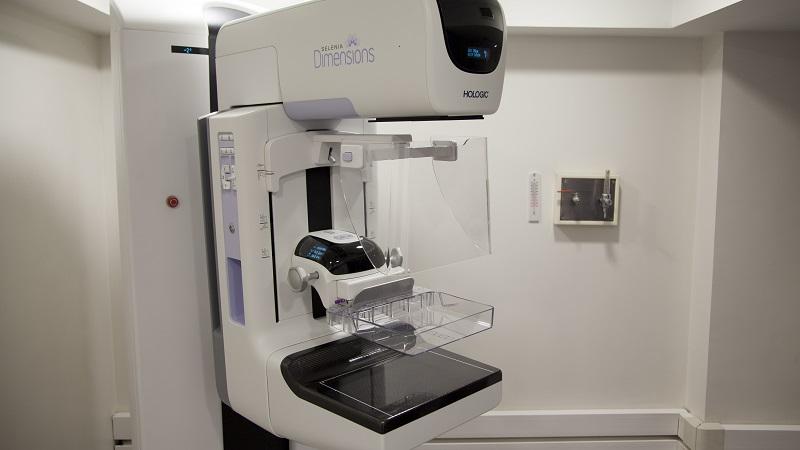Scottish academic help develop new technology that could play a key role in finding interval cancers
Credit: Elías Alarcón/Pixabay
Artificial intelligence breast screening technology developed by academics and health-service professionals could help detect abnormalities that would be missed using current screening procedures.
The development by the University of Aberdeen, NHS Grampian, and Kheiron Medical Technologies analysed 220,000 mammograms from over 55,000 people to determine how well the AI tool could detect breast cancer.
The software, named ‘Mia’, was assessed by a research team from the University of Aberdeen. Analysis found that the technology was successful in identifying potentially missed cancers, known as interval cancers – an invasive cancer diagnosed within the three-year period after a normal result.
The university team found that Mia would have suggested recalling 34.1% of women that would go on to develop cancer in between screenings.
Related content
- Artificial intelligence to empower public services, says minister
- East Midlands NHS trusts trial AI for cancer screening
- AI will save lives of 22,000 cancer patients a year, prime minister announces
Dr Clarisse de Vries, radiology imaging researcher at the University of Aberdeen, said: “Our finding is a massive step forward in using AI technology in diagnostic medicine – we showed that once ‘tuned’ to the local environment, AI can be of enormous benefit to clinicians and importantly, people who may be at risk of developing cancer. Our results show that AI, and in this case Mia, offers huge potential for detecting cancers that may otherwise be missed.”
She added: “Fundamentally however, our study shows that AI tools must be tested first and tuned for the local population and conditions, and we have been fortunate to have been able to do just that here in Grampian. Previously, it was unclear whether AI tools developed elsewhere could be used in different settings and screening centres. Now we know there are risks in just taking an AI tool developed elsewhere and implementing it locally. You must first test the tool on the local data to ensure it will work as expected.”
Professor Roger Staff, head of imaging physics at NHS Grampian, added: “This is a critical study, identifying the steps required to get this technology into service. Although the results indicate that the technology is not quite ‘plug and play,’ it has the potential for major health and operational gains for the service.”





Mexican Easy Pharm: Mexican Easy Pharm – Mexican Easy Pharm
mexican online pharmacies prescription drugs https://mexicaneasypharm.com/# Mexican Easy Pharm
medication from mexico pharmacy
medication from mexico pharmacy https://mexicaneasypharm.shop/# Mexican Easy Pharm
mexican pharmaceuticals online
https://semapharm24.com/# semaglutide tablets price
prednisone buy
farmacie online affidabili http://farmaprodotti.com/# comprare farmaci online all’estero
top farmacia online
http://phtaya.tech/# Visitors come from around the world to play.
Some casinos have luxurious spa facilities.
jugabet chile jugabet.xyz Las tragamonedas ofrecen grandes premios.
http://winchile.pro/# Los bonos de bienvenida son generosos.
Players enjoy a variety of table games.
Slot machines attract players with big jackpots. http://phtaya.tech/# Slot tournaments create friendly competitions among players.
http://phtaya.tech/# Players enjoy a variety of table games.
Slot machines attract players with big jackpots.
taya365 taya365 com login Many casinos have beautiful ocean views.
The Philippines has a vibrant nightlife scene. http://taya777.icu/# A variety of gaming options cater to everyone.
http://winchile.pro/# Las tragamonedas ofrecen grandes premios.
Loyalty programs reward regular customers generously.
Visitors come from around the world to play. https://phtaya.tech/# Gaming regulations are overseen by PAGCOR.
https://taya365.art/# Gambling can be a social activity here.
The poker community is very active here.
taya777 register login taya777 register login Poker rooms host exciting tournaments regularly.
Many casinos offer luxurious amenities and services. https://phtaya.tech/# The thrill of winning keeps players engaged.
http://jugabet.xyz/# Muchos casinos tienen salas de bingo.
Responsible gaming initiatives are promoted actively.
https://phtaya.tech/# п»їCasinos in the Philippines are highly popular.
The casino industry supports local economies significantly.
Las aplicaciones mГіviles permiten jugar en cualquier lugar.: jugabet casino – jugabet chile
Gambling can be a social activity here. https://phmacao.life/# Loyalty programs reward regular customers generously.
jugabet chile jugabet chile La historia del juego en Chile es rica.
https://phtaya.tech/# Many casinos offer luxurious amenities and services.
High rollers receive exclusive treatment and bonuses.
Cashless gaming options are becoming popular. http://winchile.pro/# Las promociones atraen nuevos jugadores diariamente.
http://taya365.art/# Resorts provide both gaming and relaxation options.
The casino atmosphere is thrilling and energetic.
Manila is home to many large casinos. http://taya777.icu/# Some casinos feature themed gaming areas.
taya365 com login taya365.art The casino atmosphere is thrilling and energetic.
https://taya777.icu/# Players enjoy a variety of table games.
Slot machines attract players with big jackpots.
https://jugabet.xyz/# Los pagos son rГЎpidos y seguros.
Manila is home to many large casinos.
http://winchile.pro/# La competencia entre casinos beneficia a los jugadores.
Poker rooms host exciting tournaments regularly.
phtaya casino phtaya login Players must be at least 21 years old.
Game rules can vary between casinos. http://taya365.art/# High rollers receive exclusive treatment and bonuses.
Online gaming is also growing in popularity.: phmacao club – phmacao casino
https://phmacao.life/# Players enjoy a variety of table games.
Players can enjoy high-stakes betting options.
jugabet chile jugabet Las promociones de fin de semana son populares.
The casino atmosphere is thrilling and energetic.: phtaya login – phtaya casino
Many casinos have beautiful ocean views. https://taya777.icu/# Slot machines attract players with big jackpots.
jugabet casino jugabet Los pagos son rГЎpidos y seguros.
http://jugabet.xyz/# Los torneos de poker generan gran interГ©s.
Manila is home to many large casinos.
http://phmacao.life/# Gambling can be a social activity here.
Players often share tips and strategies.
taya365 taya365 login Players enjoy a variety of table games.
Visitors come from around the world to play.: phtaya – phtaya login
http://taya777.icu/# Many casinos offer luxurious amenities and services.
Some casinos have luxurious spa facilities.
Most casinos offer convenient transportation options. http://phmacao.life/# Players can enjoy high-stakes betting options.
taya777 login taya777 login Slot tournaments create friendly competitions among players.
http://phtaya.tech/# Players enjoy both fun and excitement in casinos.
The Philippines has a vibrant nightlife scene.
The ambiance is designed to excite players.: taya777.icu – taya777 app
https://phmacao.life/# Visitors come from around the world to play.
Casino visits are a popular tourist attraction.
phtaya login phtaya casino Promotions are advertised through social media channels.
Gambling regulations are strictly enforced in casinos. https://phmacao.life/# The Philippines has several world-class integrated resorts.
https://jugabet.xyz/# La historia del juego en Chile es rica.
Most casinos offer convenient transportation options.
https://taya365.art/# Players often share tips and strategies.
Online gaming is also growing in popularity.
canadian prescription pharmacy https://megaindiapharm.shop/# Mega India Pharm
discount drug mart canada pharmacy not requiring prescription discount drug pharmacy
pharmacy coupons https://xxlmexicanpharm.com/# xxl mexican pharm
pharmacy discount coupons https://easycanadianpharm.shop/# pharmacy com canada
cheapest prescription pharmacy http://easycanadianpharm.com/# easy canadian pharm
buying prescription drugs from canada http://easycanadianpharm.com/# canadian pharmacy 24
cheapest online pharmacy india Mega India Pharm MegaIndiaPharm
online pharmacy prescription https://familypharmacy.company/# Online pharmacy USA
cheapest pharmacy for prescriptions http://easycanadianpharm.com/# medication canadian pharmacy
xxl mexican pharm: medication from mexico pharmacy – buying prescription drugs in mexico online
mail order pharmacy no prescription http://xxlmexicanpharm.com/# buying from online mexican pharmacy
Online pharmacy USA Cheapest online pharmacy family pharmacy
discount drug mart pharmacy: drugmart – discount drugs
MegaIndiaPharm: reputable indian online pharmacy – MegaIndiaPharm
Best online pharmacy family pharmacy Online pharmacy USA
legit non prescription pharmacies http://discountdrugmart.pro/# discount drug mart pharmacy
canadian prescription pharmacy https://easycanadianpharm.com/# easy canadian pharm
no prescription pharmacy paypal https://familypharmacy.company/# Best online pharmacy
easy canadian pharm ed meds online canada easy canadian pharm
foreign pharmacy no prescription http://xxlmexicanpharm.com/# xxl mexican pharm
online pharmacy delivery usa: online pharmacy delivery usa – Online pharmacy USA
canadian pharmacy antibiotics easy canadian pharm canadian pharmacy meds reviews
best no prescription pharmacy https://xxlmexicanpharm.com/# mexico pharmacies prescription drugs
uk pharmacy no prescription http://easycanadianpharm.com/# vipps approved canadian online pharmacy
pharmacy coupons http://easycanadianpharm.com/# reliable canadian pharmacy
reputable online pharmacy no prescription http://xxlmexicanpharm.com/# xxl mexican pharm